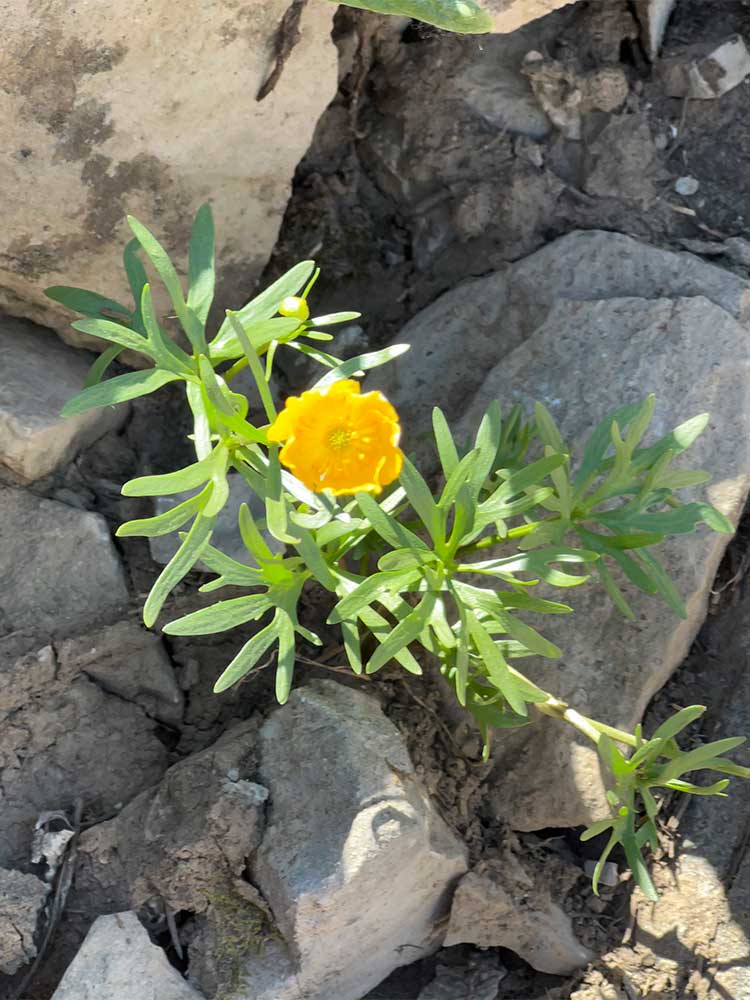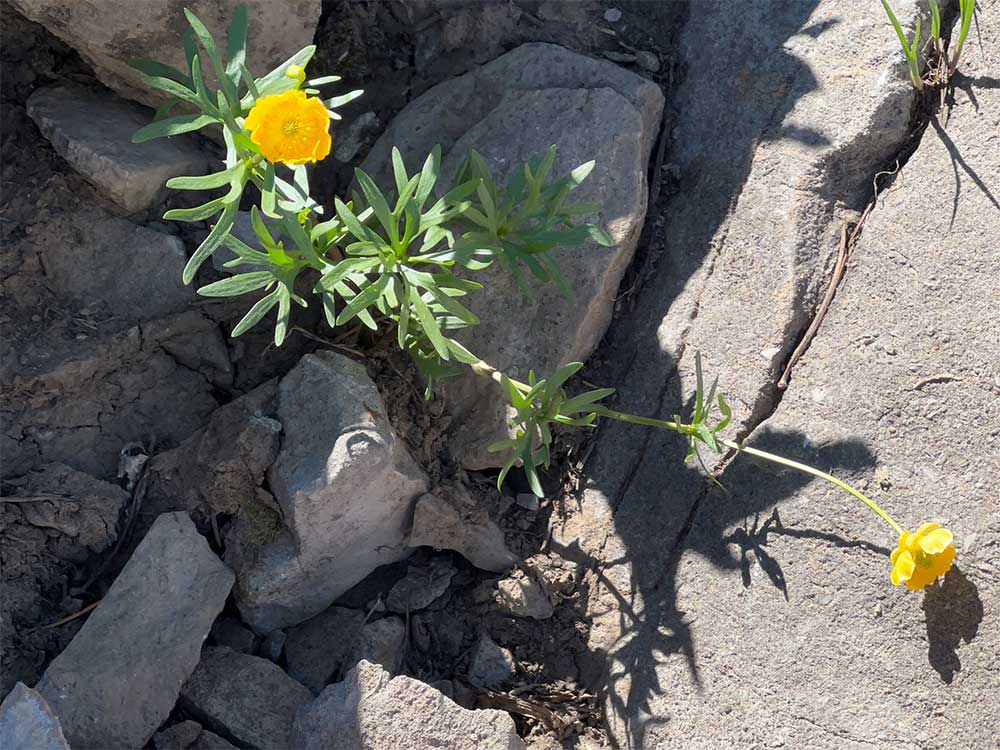Ranunculus adoneus / alpine buttercup
- short, high altitude plant
- rocks or moist meadows
- yellow “buttercuppy” flowers, 5-10 petals
- huge numbers of stigmas
- highly lobed, finely dissected leaves
Also known as: snow buttercup, western wild buttercup
This lovely plant, as it’s name indicates, is only found above 8,000 feet… in moist meadows if they’re available, or on the more shaded side of alpine rock outcrops. The photos here were taken on the east side of the Summit trail at Targhee. Otherwise, it’s found only in the Rocky Mountains. It’s a long-lived perennial.
Alpine buttercup plants emerge at the edge of melting snow and flower within a few days. Hence, flowering time is variable depending on the site. The flowers persist for approximately 10 days. Secondary flowers may open a week or two after the primary flowers.
The flowers are yellow, and very buttercuppy. They have between five and ten wedge-shaped petals and five shorter, greenish-yellow sepals. The sepals have white hairs on their lower surfaces. There are 1 to 3 flowers per stem, each being maybe 1½ inches across. The flowers avoid self-fertilization by having the pistils mature first and the anthers later. There are up to 150 pistils per flower, however, and they mature over a period of several days. Pollination is accomplished with the aid of flies and other small insects.
Initially, the flowers are low on the plant but raise up as the peduncle (stem) elongates. Interestingly (see below) this is associated with heliotropism, i.e. following the sun throughout the day.
The leaves of alpine buttercup are also about 1½ inches across and and deeply dissected. The lobes are linear and the leaf segments very narrow. The stem, which is about up to about 9″ long, arises from a thick, perennial caudex.
Interesting bits: First, I think it’s noteworthy that alpine buttercup was featured on a US forever stamp in 2022.
Beyond that, the next cool thing is that the flowers are heliotropic. This is a not-uncommon feature of alpine and arctic plants where the temperatures are low and the opportunities to reproduce are limited. Heliotropism means the flowers track the sun, like sunflowers.
That I can write this, obviously means someone studied it. So there’s more. Sun tracking occurs through the morning and until mid-afternoon, especially in younger, female stage flowers. The main effect is that the internal temperature of the flowers can be several degrees C above ambient. Warmer flowers attract more insects which results in greater pollination and seed production.
So, of course, they put up nets to exclude flies from flowers. Some selfed seeds were still produced, but way fewer than if the flowers were hand outcrossed or open pollinated. Going further, flowers that were tethered to prevent solar tracking also set fewer, lighter-weight seeds. This effect was much less if flowers were tethered during their male stage.
How does heliotropism actually work? Of course, someone studied this, too. In an article published in 2002, experiments were done to determine where photoreception occurred, which organs responded, and how movement was achieved. So first, what actually happens?
Flower (peduncles) stems bend eastward in the morning (toward the sun) and gradually unbend over the course of the day. The region of greatest bending is somewhat below the actual flower, say between ½ and 1″. Scientists can be a weird lot, so they also found that the tip of the peduncle continues to track the sun even if the flower itself is cut off. And by selectively shading parts of the peduncle, they zeroed in on the region just below where the flower attaches as the most sensitive area.
Because plants don’t have muscles to move flowers around, heliotropism requires actual differences in cell growth, especially epidermal cells. Bending toward the sun reflects the fact that 40% more growth occurred on the shaded side of flowerless peduncles. This same differential growth thing determines sun tracking in sunflowers. Whether the sensing regions and molecular mechanisms are the same or not is an open question… since the molecular sorts haven’t seen fit to study buttercups. Certainly, the thermoecology of the two species is different.
Enough of that. Other physiological processes in alpine buttercups have also received interesting attention, e.g. how it acquires N and P which are both highly limiting nutrients in alpine ecosystems, and the relationship between altitude and population structures and genetics.
This is truly a fun little plant.

